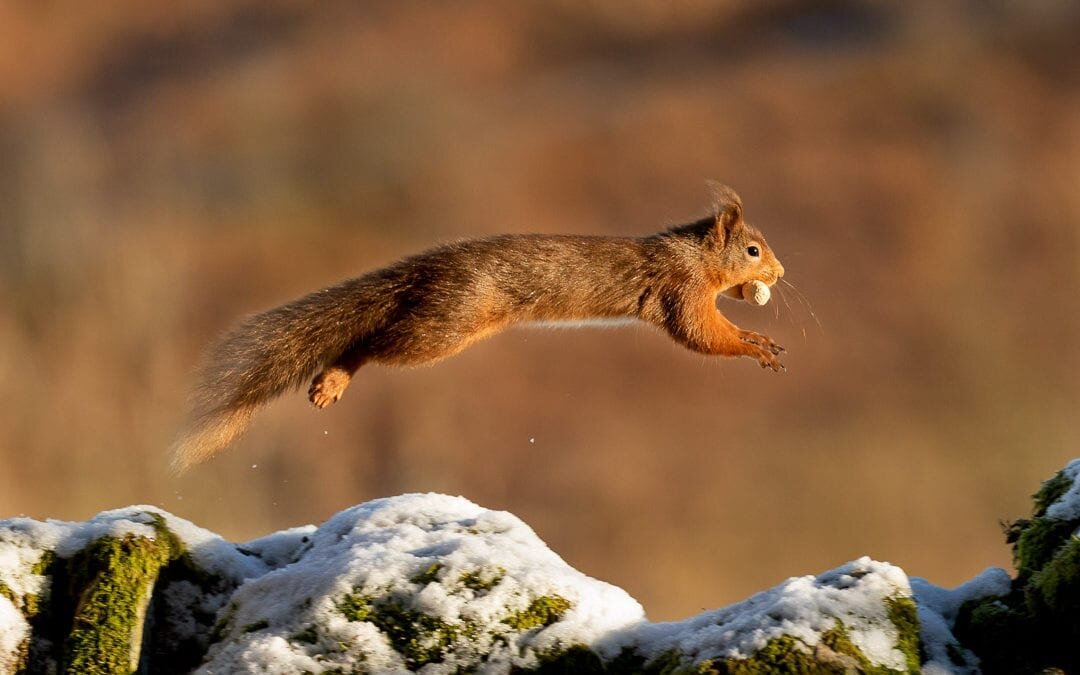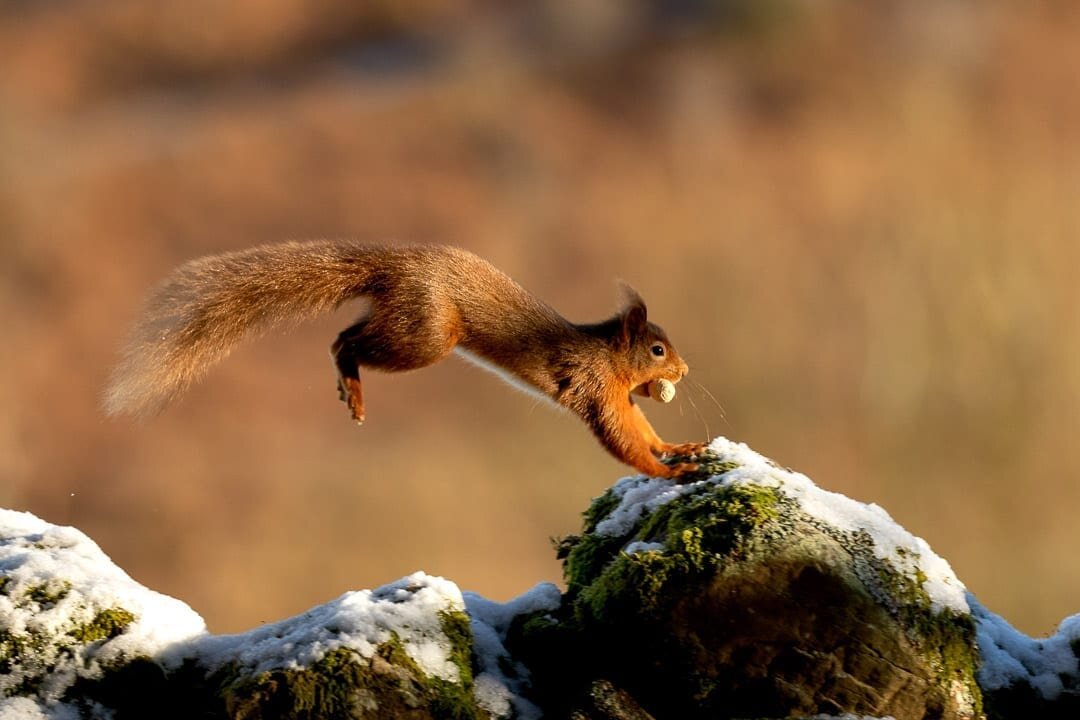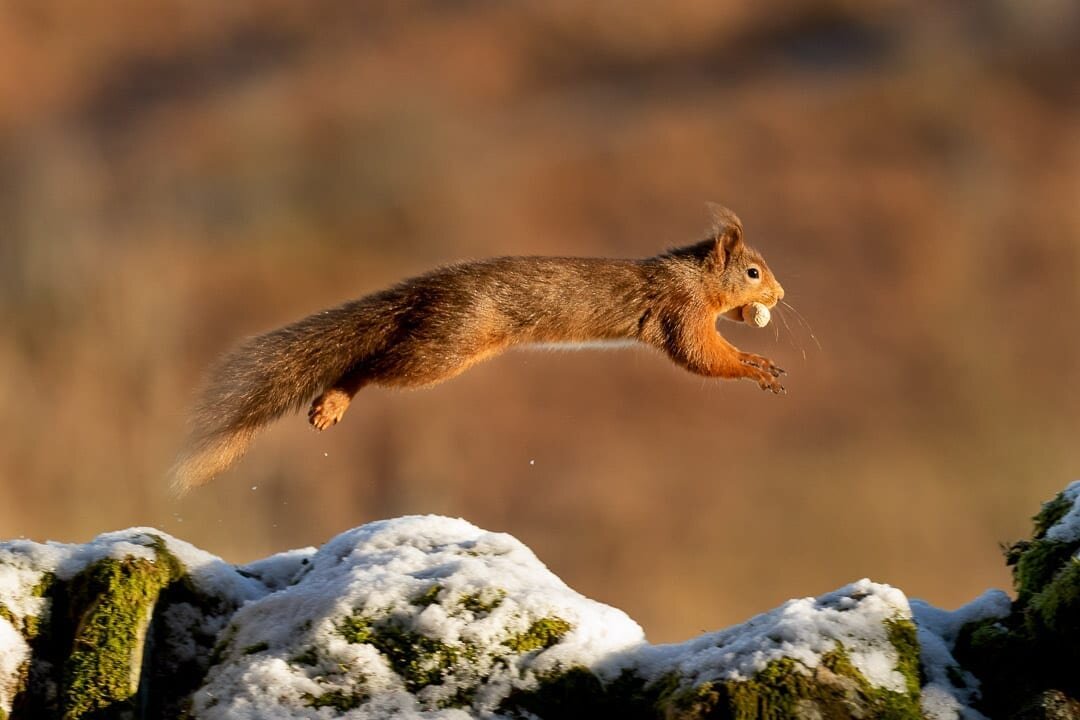May 14, 2019
Photographing Jumping Red Squirrels in Cumbria
On a recent trip to Cumbria I came across a small population of red squirrels in a patch of conifer woodland, near the North Pennines. I met a local man who feeds them daily, and after a bit of a reconnaissance mission to scout out the area, I reckoned this would be a great opportunity to capture some shots of red squirrels jumping as they ran back and forth along the dry stone walls during feeding times.
Red Squirrel Ecology
Red squirrels are native to the UK, but came under threat from greys which were introduced from the United States in the early 1900s. Now red squirrels are only found in Scotland, Northern Ireland and a few places in England. Once widespread across the UK, numbers are declining and estimates put the red squirrel population at just 161,000 individuals.
They are a woodland specialist, spending around 75% of their time in trees. I knew of this population in Cumbria in the Scots Pine forest, and as I spent a bit of time getting familiar with their behaviour, I could see how they were using the woodland corridors and the walls to move about.
Scouting for Red Squirrel Project
I spent a bit of time in the area trying different compositions and different angles to shoot from, but I really wanted to capture some images of them running and jumping along the walls.
The dry stone walls around Cumbria and the Lake District are probably more iconic than the squirrels themselves – and they’re quite famous around the world. (There’s even a museum in the Cumbrian town of Coniston which celebrates them and the traditional ways they are built!)
400mm, 1/500s, f/5.6, ISO 640
But back to the squirrels.
They were being fed peanuts at feeding boxes in the woodland, so my objective was to photograph the squirrels jumping as they ran along the top of the wall, jumping from stone to stone.
These kind of images are possible in setup hides that I know of around Scotland, but I really wanted to get this kind of shot in the wild. Much of the time the squirrels would be carrying food in their mouths, which could seem slightly artificial or set up, so I was keen to also capture them on their way up to the feeding platform, i.e. without them carrying the nuts.
200mm, 1/1600s, f/5, ISO 640
However, as the morning light was falling on the squirrels as they ran away from the feeding platform, the captures of squirrels with nuts in their mouths were much better lit.
The photo shows the awkward angle of the light when the squirrels were running towards the feeding station.
Red Squirrel Photography in the Field
The first time I photographed the squirrels, I used a hide. This was really useful to get closer to the squirrels without disturbing them and experimenting with a different angle. You can check out a video I did on this for Tragopan below.
Without a hide, it all came down to finding a position that I hoped would be good, hunkering down … and … just having patience.
I’m glad to say it paid off.
278mm, 1/1250s, f/5, ISO 640
278mm, 1/1250s, f/5, ISO 640
I spent a couple of days on this project and I was really happy with the results. Even though on the second day winter really hit, temperatures plummeted to -4, and I had to really gear up for it.
Squirrels have such fluffy tails to keep them warm during winter, but I was quite warm enough with my Montane ski trousers a.k.a. Fatsuit, fleece and Muckboots. You can check out my full gear list here!
Because it was winter, I could make the most of the low light and the angle of sun, and I even got some snow in the background which really added to the photos I got.
Camera Settings for Jumping Red Squirrels
I was using the Canon 100-400mm f/4 5-5.6 mark ii lens, which I find to be unbelievably versatile and sharp. You can check out a video review of this lens here.
I used the lens mostly at around 300mm, partly because I was quite close to the wall and I wanted to show more of the environment, but also because it was easier to capture the fast jumping squirrel with more space in the frame.
At 300mm the lens allows an f-stop of f/5 and I used a shutter speed of 1/1250s and 1/1600s, both speeds froze the action of the jumping squirrel. I shot in manual mode and set my ISO to 640 to get a good exposure, which the Canon 7D mark ii handles easily.
278mm, 1/1250s, f/5, ISO 640
Do you get red squirrels where you are? Have you tried to photograph them jumping?
It’s good fun 🙂






be the first to comment